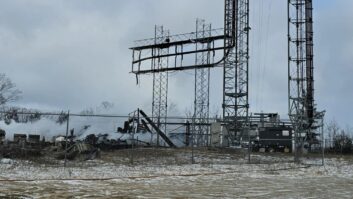(click thumbnail)Fig. 1: A new carnival ride?Fig. 1 looks more like the track of a Busch Gardens roller coaster than an AM tower, and it brings to mind how important quarterly tower inspections are.
At the recent Oklahoma Association of Broadcasters SBE Engineering Conference, R. Dale Gehman, principal of Gehman Compliance and Consulting, spoke about the importance of keeping towers maintained — particularly through conducting a quarterly tower inspection. Dale performs the Alternative Broadcast Inspection Program for several states.
Although he did not supply the picture shown here, it’s typical of some of the poorly maintained sites he’s witnessed.
He’s also seen a lot of well-maintained sites, too. Head to Dale’s Web site www.gradiotv.com for more information on his services.
Dale also provides a link to a useful site, OnlineConversion.com, which converts just about anything into anything else.
As for Fig. 1, its source is anonymous!
* * *
Mike Manley of Amick Sound replies on our topic of remote-control toy trucks being used to pull cables across grid-tile ceilings (Workbench, Jan. 2).
It’s been Mike’s experience that the “off-road” type trucks handled most obstructions pretty well, and only encountered trouble with the larger light fixtures.
(click thumbnail)Fig. 2: Small animals may lurk above those studio ceiling tiles, hard at work.Although he did not witness it personally, a coworker told him about using a small dog for the same purpose. The telephone contractor attached a pull string to the leash, put the dog up through the trapdoor, closed it and went to the other end of the hall and called, “Here, boy!”
Mike offers two other suggestions for dropping wires down walls with insulation:
First, use a 102-inch CB whip antenna. It works well, and you can’t beat the length.
The second suggestion is to use the metal backing strip from WireMold 500 or 700 raceway. This is a 1/2-inch-wide strip of sheet metal that can flex up into the wall, but won’t bend left or right to wander off course.
Of course, the fiberglass screw-together push rods work well, but at a higher cost. If they aren’t on site, they’re not much use!
Recently, Mike was pulling cables for a CCTV installation at a VA hospital into a secure IT room. The contractor’s escort was watching Mike and his crew use the fiberglass pushrods and commented, “You guys have all the fancy equipment. Here’s what our IT guys use to fish wire.” He held up a straightened coat hanger.
I guess what you have on hand and that solves the problem is the proper tool for the job.
* * *
The man who provided the “Smoke on the Watter” photo for our recent caption contest, Contract Engineer John Ramsey, sent a note asking how other contract engineers handle the storage of client keys.
An excellent question for our readers, John, especially when one considers the liability of the keys falling into the wrong hands.
I’d like to get your thoughts; in the meantime, I’ll share mine.
When I had a contracting business, we copied the keys so each employee had complete sets for each client. We had the locksmith stamp “do not duplicate” on the keys, and billed each station for the key duplication. We informed our clients we were going to do this, and they had a choice: pay for the copies or leave a master set at the studio.
(click thumbnail)Fig. 3: All those knobs on exposed electronic test equipment scream, ‘Take me!’If they chose to leave a set at the studio, the additional time that they were off the air while our engineer drove to pick up the keys was enough incentive to pay to have the keys copied.
Standardizing keys, and using resettable Master combination locks, helped keep the key count per station low; but we still had a lot of keys on various key rings.
Each engineer kept the keys in an old plastic Sennheiser or metal Electro-Voice microphone case; either will store a lot of key rings. The box usually was kept under the seat of the engineer’s vehicle, out of sight.
It may have been luck, but we never had an instance of stolen or missing keys. But John’s question is a good one.
Do you label the keys with a code, or the call letters? Do you keep the keys at your office, and just take the sets with you for the clients you will visit that day?
And if so, what about emergencies? Contract engineers don’t always know where they will be from one day to the next. If you store the keys in your vehicle overnight, what are your thoughts about the best way to secure the keys?
With site security such a concern, I’d like to touch a bit on that last question.
Although having a vehicle with your company logo on the side looks professional, it also alerts thieves. To them, engineering equals money! Better a magnetic sign that you can remove, or no sign at all.
Just as important is a trunk or covered storage so tools aren’t openly exposed. Tool boxes, scopes, a GPS or cell phone (and visible open box of keys) can prove to be just too tempting.
So my 2 cents is to keep things out of sight. I’ll look forward to sharing your comments with readers in a future column.















